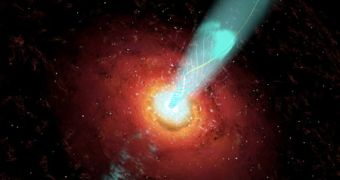Supermassive black holes are mostly found in galactic nuclei, ejecting matter in the form of particle jets at relativistic speeds during the 'feeding' process. According to theory, these particle jets are accelerated to these speeds by tightly-twisted magnetic fields generated in the close proximity of the black hole. However, confirming this theory has proved rather problematic until now. National Ratio Astronomy Observatory's Very Long Baseline Array observations showed that particle jets ejected by black holes behave just as predicted by the theory.
"We have gotten the clearest look yet at the innermost portion of the jet, where the particles actually are accelerated, and everything we see supports the idea that twisted, coiled magnetic fields are propelling the material outward. This is a major advance in our understanding of a remarkable process that occurs throughout the universe," said Boston University researcher Alan Marscher.
The objects studied during the research are located within the blazar BL Lacertae, 950 million light years away from Earth. Blazars are extremely energetic galactic nuclei powered by supermassive black holes. These, on the other hand, are objects of extreme mass concentrated in a very small region of space, with infinite density and powerful gravitational pull. In fact, it is so powerful that not even light can escape from being pulled in towards the singularity.
As matter is pulled towards the black hole, it is first shaped into a disk of matter spinning around it, the so-called accretion disk. Matter moving within the accretion disk is heated to extreme temperatures, and starts emitting X-ray light at some point in time, while the magnetic field perpendicular to the accretion disk are twisted so that jet particles are ejected through both black hole poles. And this is not restricted only to the magnetic lines; the black hole's powerful gravitational pull creates a frame drag that twists even the space-time fabric of the universe.
Marscher argues that the observations conducted during the period of time between 2005 and 2006 fall within the theoretical predictions, including the material outburst predicted by Boston University, a knot of matter ejected in the direction of the particle jet during the collision with a stationary shock wave. The VLBA had the role of locating the material flare, the properties of the phenomenon where measured with the help of other telescopes.
"We got an unprecedented view of the inner portion of one of these jets and gained information that's very important to understanding how these tremendous particle accelerators work," Marscher said.

 14 DAY TRIAL //
14 DAY TRIAL //